RDA and FRBR - Joint Steering Committee for Development of RDA
RDA and FRBR - Joint Steering Committee for Development of RDA
RDA and FRBR - Joint Steering Committee for Development of RDA
Create successful ePaper yourself
Turn your PDF publications into a flip-book with our unique Google optimized e-Paper software.
Slide 1<strong>RDA</strong> <strong>and</strong> <strong>FRBR</strong>:Next Big Things in CatalogingMassachusetts Library AssociationTechnical Services SectionMay 4, 2007Barbara B. Tillett, Library <strong>of</strong> CongressThank you <strong>for</strong> inviting me to be with you today. I just recently came back from the JSCmeetings in Ottawa (April 16-20 <strong>and</strong> the meetings in London <strong>for</strong> <strong>RDA</strong> with representativesfrom the Dublin Core, IEEE/LOM, <strong>and</strong> World Wide Web Consortium, (W3C) Semantic Webcommunities – also included W3C Semantic Web <strong>and</strong> SKOS folks, so I’m very glad to sharewith you the latest news – hot <strong>of</strong>f the presses as it were!H<strong>and</strong>outs
Slide 3What is <strong>FRBR</strong>?• IFLA’s FunctionalRequirements <strong>for</strong>Bibliographic Records (<strong>FRBR</strong>)• User tasks• Find• Identify• Select• Obtain• Conceptual model•Entities, Relationships,Attributes• M<strong>and</strong>atory elements <strong>for</strong> anational level bibliographicrecordYou have a h<strong>and</strong>out on “What is <strong>FRBR</strong>?” to give you a bit more in<strong>for</strong>mation. I will only be ableto very quickly cover <strong>FRBR</strong> today. How many <strong>of</strong> you are already familiar with <strong>FRBR</strong> – alreadyhave a good idea <strong>of</strong> what it is?IFLA – the International Federation <strong>of</strong> Library Associations <strong>and</strong> Institutions has been thecenter <strong>for</strong> global bibliographic st<strong>and</strong>ards <strong>for</strong> decades.The IFLA conceptual model, Functional Requirements <strong>for</strong> Bibliographic Records, or <strong>FRBR</strong>,rein<strong>for</strong>ces the objectives <strong>of</strong> catalogs <strong>and</strong> the importance <strong>of</strong> relationships to help users to fulfillbasic tasks with respect to the catalog – enabling them to find, identify, select, <strong>and</strong> obtainin<strong>for</strong>mation they want. These are the <strong>FRBR</strong> ‘User tasks.’<strong>FRBR</strong> also <strong>of</strong>fers us a structure to meet those basic user tasks. It includes an entityrelationshipmodel, which is a conceptual model <strong>of</strong> how the bibliographic universe works –identifying its entities <strong>and</strong> relationships. It provides ways to collocate records at the level <strong>of</strong>works <strong>and</strong> expressions, to show relationships. It also includes the functional requirements,that is, the set <strong>of</strong> data elements or attributes that are m<strong>and</strong>atory <strong>for</strong> a national levelbibliographic record.
Slide 4Other International<strong>Development</strong>s• Conceptual models• <strong>FRBR</strong>• FRAD <strong>for</strong> authority data• FRSAR•Updating the ParisPrinciples (IME ICC)• IFLA Meeting <strong>of</strong> Expertson an InternationalCataloguing CodeAnd now there is a companion data model <strong>for</strong> authorities: FRAD – Functional Requirements<strong>for</strong> Authority Data. It was just sent out <strong>for</strong> worldwide review April 12 th <strong>and</strong> you can find it onthe IFLANET web site.Besides <strong>FRBR</strong> <strong>and</strong> FRAD, IFLA has also produced a draft statement <strong>of</strong> internationalcataloguing principles to update the 1961 Paris Principles – this new set <strong>of</strong> principles is beingvetted by cataloging rule makers worldwide through the IFLA Meetings <strong>of</strong> Experts on anInternational Cataloguing Code, known as IME ICC. All <strong>of</strong> these international developmentsare taken into account by the <strong>Joint</strong> <strong>Steering</strong> <strong>Committee</strong> <strong>for</strong> <strong>Development</strong> <strong>of</strong> <strong>RDA</strong> as we arelooking towards the future in developing <strong>RDA</strong>.Be<strong>for</strong>e I get into talking more about <strong>RDA</strong>, let me take a moment to go back to <strong>FRBR</strong> toprovide at least a little more explanation <strong>of</strong> what it is <strong>and</strong> how it affects <strong>RDA</strong>. <strong>FRBR</strong> was theresult <strong>of</strong> several years <strong>of</strong> work by the IFLA Study Group on Functional Requirements <strong>for</strong>Bibliographic Records – I was a consultant to that group along with Tom Delsey <strong>and</strong> ElaineSvenonius. Our report was.published in 1998 <strong>and</strong> introduced some new vocabulary.
Slide 5Vocabulary• “Book”–Door prop(item)–“publication”at bookstoreany copy(manifestation)Vocabulary is really very important in times <strong>of</strong> change <strong>and</strong> across communities that might use<strong>RDA</strong> – including system designers.For <strong>FRBR</strong>, terminology was carefully selected to be more clear than our current Englishlanguage. Let me give you an analogy from Patrick LeBoeuf (<strong>for</strong>merly chair <strong>of</strong> the <strong>FRBR</strong>Review Group <strong>for</strong> IFLA) – using the English word <strong>for</strong> “book” as we look at <strong>FRBR</strong>’s Group 1entities.When we say ‘book,’ what we have in mind may be a distinct, physical object that consists <strong>of</strong>paper <strong>and</strong> a binding <strong>and</strong> can sometimes serve to prop open a door or hold up a table leg –<strong>FRBR</strong> calls this an item.When we say ‘book’ we also may mean “publication” as when we go to a bookstore to ask <strong>for</strong>a book identified by an ISBN – the particular copy does not usually matter to us, provided itbelongs to the general class <strong>of</strong> copies we require <strong>and</strong> no pages are missing- any <strong>of</strong> thecopies with the same content <strong>and</strong> in the same <strong>for</strong>mat will do – <strong>FRBR</strong> calls this manifestation.
Slide 6Vocabulary•“Book”–Who translated?(expression)–Who wrote?(work)*When we say ‘book’ we could use the word as in “who translated that book?” – we may havea specific text in mind in a specific language or a translation – <strong>FRBR</strong> calls this expression.*When we say ‘book’ as in “who wrote that book?” - we could also mean a higher level <strong>of</strong>abstraction, the conceptual (intellectual or artistic) content that underlies all <strong>of</strong> the linguisticversions, the basic story being told in the book, the ideas in a person’s head <strong>for</strong> a book –<strong>FRBR</strong> calls this work.When you hold a book in your h<strong>and</strong> – it’s all 4 <strong>of</strong> those entities – an example <strong>of</strong> amanifestation (which is what we catalog <strong>and</strong> describe - to be re-used by other libraries oranyone anywhere <strong>and</strong> it embodies a particular expression <strong>of</strong> a work.We want our language to be more precise to help with future system design <strong>and</strong> futurecataloging rules. On Monday <strong>and</strong> Tuesday this week the <strong>RDA</strong> Outreach Group organized ameeting with representatives from several metadata communities – mostly Dublin Core, <strong>and</strong>also IEEE/LOM, Semantic Web, W3C, <strong>and</strong> SKOS. H<strong>and</strong>out with vocabularyrecommendations
Slide 8Relationships Inherentto the Group 1 Entities• Work “is realized by” an expression• Expression “is embodied in” amanifestation•Manifestation “is exemplified by”an item•ItemLet’s now move on to relationships <strong>for</strong> the Group 1 entities. Relationships are naturally a bigpart <strong>of</strong> the <strong>FRBR</strong> entity-relationship model.There are also several types <strong>of</strong> relationships that we can consider.Within <strong>FRBR</strong> there are relationships that are inherent among the entities : A work “is realizedby” by an expression – that’s a relationship,<strong>and</strong> an expression “is embodied in” a manifestation – that’s a relationship.A manifestation “is exemplified by” an item – that’s a relationship.But how do we know about these relationships? We rely on in<strong>for</strong>mation that we pick up fromexamining an item.Sometimes that item will self-describe which work it contains.A characteristic <strong>of</strong> a work (like its subject or what it is about or its name or the name <strong>of</strong> itscreator) is carried to all the entities below it in the hierarchy. This is important because wecould associate certain descriptors at the work level that then could apply to all records <strong>for</strong> theassociated manifestations… more about this when we look at scenarios.
Slide 9WorkExpressionManifestationRelationships• Inherent amongthe entitiesItem• Contentrelationshipsamong worksWhole-PartAccompanyingSo, there are inherent relationships among the entities, like saying “a work is realized throughan expression or “an expression is embodied in a manifestation”.Another way to look at this is through the content relationships among works, that are theninherited by their expressions, manifestations, <strong>and</strong> items. Many years ago I suggested ataxonomy <strong>of</strong> relationships: equivalence, derivative, descriptive, whole/part, <strong>and</strong> part-to-part(sequential <strong>and</strong> accompanying), <strong>and</strong> shared characteristics relationships. These contentrelationships <strong>and</strong> inherent relationships will be covered in <strong>RDA</strong> in chapter 7.Some <strong>of</strong> these relationships are described in <strong>FRBR</strong>, such as equivalent, derivative, <strong>and</strong>descriptive relationships <strong>of</strong> the content. There are also whole-part relationships withaggregates <strong>and</strong> their components.Any <strong>of</strong> these content relationships that are identified at the work level are also inherited by thehierarchically related expressions, manifestations, <strong>and</strong> items.
Slide 10EQUIVALENTFamily <strong>of</strong> WorksDERIVATIVEDESCRIPTIVEMicro<strong>for</strong>mreproductionCopyExactreproductionReprintFacsimileSimultaneous“publication”TranslationEditionsRevisionVariations or versionsAbridgededitionIllustratededitionExpurgatededitionArrangementSlightmodificationsFreetranslationSummaryAbstractDigest DramatizationNovelizationScreenplayLibrettoChange <strong>of</strong> genreAdaptationsParodyImitationsSame style orthematic contentReviewCasebookCriticismAnnotatededitionEvaluationCommentaryOriginalSame workNew workSameExpressionNew ExpressionCataloging Rulescut-<strong>of</strong>f pointNew WorkB. Tillett10 Dec. 2001This picture is from my latest update <strong>of</strong> the taxonomy <strong>of</strong> bibliographic relationships that waspublished by Kluwer 1 in 2001 (<strong>and</strong> in the What is <strong>FRBR</strong>?” brochure). It shows a continuum <strong>of</strong>the relationships within a family <strong>of</strong> works as represented in manifestations moving from left toright. On the left are those that are equivalent, that are from the same expression <strong>of</strong> the work.Once we introduce a change to the content, like a translation, we have a new expression <strong>of</strong>the same work <strong>and</strong> further changes move us to the right, farther away from the original. (Thiswill be reflected in ch. 7 <strong>of</strong> <strong>RDA</strong>.)Once that derivation crosses the magic line <strong>of</strong> becoming more <strong>of</strong> the work <strong>of</strong> another personor corporate body, we consider it a new work, but it is part <strong>of</strong> the family <strong>of</strong> related works, evenwhen the work moves on to be only describing a work in the family at the right end <strong>of</strong> thiscontinuum. The entities in descriptive relationships at the right side <strong>of</strong> this picture, can evenbe considered to be in subject relationships in <strong>FRBR</strong> terminology <strong>and</strong> the conceptual model.The ability to in<strong>for</strong>m the user <strong>of</strong> these related works ties back to the collocating <strong>and</strong> findingfunctions <strong>of</strong> a catalog again. The <strong>FRBR</strong> model reminds us <strong>of</strong> these important relationshipsthat we should reflect in our catalogs <strong>for</strong> our users.1In: Relationships in the Organization <strong>of</strong> Knowledge. – Carol Bean <strong>and</strong> Rebecca Green, eds.– Kluwer, 2001 (ISBN: 07923-68134)
Slide 11Group 1 Entities’ Attributes• Work• ID• Title• Date• etc.Expression•• ID• Title• Form• Date• Language• etc.Manifestation•• ID• Title• Statement <strong>of</strong> responsibility• Edition• Imprint (place, publisher,date)• Form/extent <strong>of</strong> carrier• Terms <strong>of</strong> availability• Mode <strong>of</strong> access• etc.Item•• ID• Provenance• Location• etc.Moving on, the attributes in <strong>FRBR</strong> (or “metadata”). Here you see some <strong>of</strong> the essentialattributes or elements that we associate with each <strong>of</strong> the primary entities. The elements areused to build a bibliographic description <strong>and</strong> its access points.For a work, the main elements are a title, date, possibly its identifier (if it has one, e.g., <strong>for</strong>rights management). What’s missing?You notice we don’t have “author” as an attribute <strong>for</strong>work or expression, because that in<strong>for</strong>mation is treated in this model as a relationshipbetween the work or expression <strong>and</strong> a person or corporate body. In naming a work, it’sessential to declare that relationship to the name <strong>of</strong> the creator <strong>of</strong> the work, but by keeping it aseparate entity we are better able to control the display <strong>of</strong> the names.Yet you see at manifestation, we have the statement <strong>of</strong> responsibility as found on the itembeing cataloged - that is in<strong>for</strong>mation unique to the manifestation <strong>and</strong> is description.For our purposes the activity <strong>of</strong> recording an expression, turns an entity into something <strong>of</strong>interest to a library - something we would add to library collections <strong>and</strong> catalog - <strong>for</strong> which wewould provide bibliographic control – namely a manifestation. In the digital world <strong>of</strong>ten wefind the basic bibliographic description is an integral part <strong>of</strong> a digital object - the s<strong>of</strong>tware thathelps create the digital object or digitizes an analog object, can automatically provide a basicset <strong>of</strong> metadata, that is attributes or data elements. Think <strong>of</strong> how the s<strong>of</strong>tware <strong>for</strong> wordprocessing, like Micros<strong>of</strong>t’s Word, suggests a name <strong>for</strong> your document based on the firstwords you type - ironically the “titles” <strong>for</strong> early manuscripts were the first line <strong>of</strong> text. S<strong>of</strong>twarenow also automatically provides the date you created it. There is already a camera that hasbuilt in the MPEG-7 st<strong>and</strong>ards <strong>for</strong> creating basic metadata <strong>for</strong> the digital images it captures.So we can envision the automatic creation <strong>of</strong> some <strong>of</strong> the attributes we’d need <strong>for</strong>bibliographic control <strong>for</strong> description <strong>and</strong> access. The draft <strong>of</strong> <strong>RDA</strong> builds on this to emphasizetranscribing what you see <strong>for</strong> the basic elements <strong>of</strong> bibliographic description following theprinciple <strong>of</strong> accurate representation.
Slide 12WorkExpressionManifestationGroup 2Entities<strong>FRBR</strong>Itemis owned byis produced byis realized byis created byPersonCorporate BodymanyLet me now move on to the entities <strong>and</strong> relationships <strong>for</strong> what <strong>FRBR</strong> calls the Group 2entities: person <strong>and</strong> corporate body.You see the relationships with the Group 1 entities in this picture:work is created by a person or corporate bodyexpression is realized by a person or corporate bodymanifestation is produced by a person or corporate bodyitem is owned by a person or corporate body.These are entities, that are <strong>of</strong> interest in authority work - as well as the Group 3 entities wewill soon see. The names <strong>of</strong> these entities are controlled when they are used as accesspoints in bibliographic records.
Slide 13<strong>FRBR</strong>Entities:PersonFamilyCorporate BodyWorkExpressionManifestationItemConceptObjectEventPlaceDRAFT FRADextension to <strong>FRBR</strong>NameIdentifierAccess PointRulesAgencyThis picture is meant to give you an idea <strong>of</strong> the direction FRAD is taking.The arrows represent the relationships:An <strong>FRBR</strong> entity at the left is “known by” a name <strong>and</strong> is “assigned” an identifier.An access point is “based on” a name or identifier.Access points are “governed by” rules that are in turn “applied by” an agency, <strong>and</strong> the accesspoints are also “created by” or “modified by” an agency.There is another IFLA Working Group that started in 2005 to look at Group 3 entities <strong>and</strong>Subject authority records. That group is being led by Marcia Zeng <strong>of</strong> Kent State University<strong>and</strong> Maja Žumer from the National Library <strong>of</strong> Slovenia.
Slide 14Workhas as subjecthas as subjecthas as subjectWorkExpressionManifestationItemPersonCorporate BodyConceptObjectEventPlace<strong>FRBR</strong>Group 3Subject <strong>of</strong>WorksmanyGroup 3 entities in <strong>FRBR</strong>, introduce all the entities that can be the subject <strong>of</strong> works :conceptobjecteventplace<strong>and</strong> all <strong>of</strong> the Group 1 <strong>and</strong> Group 2 entities because, <strong>for</strong> example, you can have a work aboutanother work. (Activities now <strong>of</strong> the FRSAR group)So we have all these entities <strong>and</strong> relationships <strong>and</strong> attributes in the conceptual model – howmight we apply this model? There are many ways we could apply <strong>FRBR</strong> <strong>and</strong> some systemdesigners are exploring several implementation scenarios.
Slide 15Possible <strong>FRBR</strong> applicationsScenario A - NowAuthorityWork/ExpressionUni<strong>for</strong>mTitlePersonSeries(work/expression)Uni<strong>for</strong>mTitleConceptBibliographicManifestationHoldingItemLet’s look at this scenario A: it’s basically how we catalog now <strong>and</strong> you can see the <strong>FRBR</strong>entities <strong>and</strong> relationships as we walk through this scenario: Our current MARC <strong>for</strong>mat hasauthority records, bibliographic records, <strong>and</strong> holdings records.{click} we start with an item we have at h<strong>and</strong>. In some <strong>of</strong> our systems- the attributes <strong>of</strong> anitem are documented in a holdings record.From the item we have at h<strong>and</strong>, we construct a {click} bibliographic record building the set <strong>of</strong>data elements that are intended to describe the manifestation, that is any copy heldanywhere, so the record can be re-used by others in a shared cataloging environment.We also make {click} authority records to control the way we identify works <strong>and</strong> expressions{click} that are embodied in the manifestation we are describing, <strong>and</strong> that in turn may belinked to a name authority record <strong>for</strong> the person {click} or corporate body that is responsible<strong>for</strong> creating the work or expression or to {click} subject headings or concepts. In someintegrated library systems this link between the bib <strong>and</strong> authority records is real, which alsomakes database maintenance <strong>and</strong> global update changes easier than when these links arenot present.
Slide 16AuthorityWork/ExpressionUni<strong>for</strong>mTitlePerson/CorporatebodyScenario BPerson/CorporatebodySeries(work/expression)Uni<strong>for</strong>mTitleConceptBibliographicManifestationHoldingItemHere’s a scenario B <strong>for</strong> the future, where we would make use <strong>of</strong> authority records <strong>for</strong> works<strong>and</strong> expressions <strong>and</strong> do more linking directly at the authority record level <strong>for</strong> the {click}creators <strong>of</strong> works <strong>and</strong> {click} classification <strong>and</strong> subject headings that are appropriate to thework. Those authority records would also be available to display <strong>for</strong> each linked bib record,<strong>and</strong> we could save cataloger’s time by not needing to classify <strong>and</strong> provide subject headings<strong>for</strong> all the manifestations <strong>of</strong> that same work/expression combination. Using <strong>FRBR</strong> helps ussee these possibilities <strong>and</strong> hopefully will aid system designers in developing future systems.I really like this model, but we need to experiment to see if this is best or perhaps there is abetter implementation model <strong>for</strong> <strong>FRBR</strong>.
Slide 17• CollocationBetter organization to catalog• Easier cataloging<strong>FRBR</strong> Benefits• Reduction in cataloging loadWork only cataloged once <strong>for</strong> all expressions <strong>of</strong> itExpression only cataloged once <strong>for</strong> all manifestations<strong>of</strong> itItem cataloging (already simple) remains the sameVTLS was the first vendor <strong>of</strong> integrated library management systems to embrace <strong>FRBR</strong> <strong>and</strong>to test their vision <strong>of</strong> how to implement <strong>FRBR</strong>. In their presentations they explain their views<strong>of</strong> the benefits <strong>of</strong> applying <strong>FRBR</strong> to their system:They find that with <strong>FRBR</strong>, the principle <strong>of</strong> collocation is expressed in a much better waybecause you have a better <strong>and</strong> more easily understood organization to the catalog. It’s moreintuitive to group the translations <strong>and</strong> editions <strong>and</strong> per<strong>for</strong>mances (expressions) <strong>and</strong> thevarious manifestations <strong>of</strong> those expressions under the work that is contained in thosemanifestations.Cataloging is easier with <strong>FRBR</strong> because the system can take advantage <strong>of</strong> the <strong>FRBR</strong>structure to automate the inheritance <strong>of</strong> identifying in<strong>for</strong>mation – metadata from the highestlevels <strong>of</strong> linked descriptions.<strong>FRBR</strong> Work <strong>and</strong> Expression records need only to be cataloged once. Right now, undertraditional cataloging, catalogers have to repeat the Work <strong>and</strong> Expression elements everytime they catalog a new edition <strong>of</strong> a work. Remember the scenario I showed you earlier <strong>of</strong>using the authority records <strong>for</strong> work <strong>and</strong> expression records with linked subject in<strong>for</strong>mation….
Slide 18<strong>FRBR</strong> BenefitsCirculation: Place holds at “Work” or“Expression” level rather than only atmanifestation level(VTLS <strong>and</strong> OCLC demonstrate this)In the area <strong>of</strong> circulation, the VTLS system uses <strong>FRBR</strong> to make it easier to find all <strong>of</strong> themanifestations. A user can place holds <strong>and</strong> requests at the Work or Expression level whenthey do not really care which edition <strong>of</strong> a particular title they get; they may just want any copy<strong>of</strong> the work.With a traditional system when you had multiple editions <strong>of</strong> a particular title (Work) you had toplace individual requests on each edition (Manifestation). With a <strong>FRBR</strong> system, you only haveto place a request at the Work or Expression level, <strong>and</strong> ANY item <strong>of</strong> ANY Manifestation willsatisfy the request. So, system design can take advantage <strong>of</strong> this <strong>FRBR</strong> model to improveuser service.
Slide 19Serial ExampleEach <strong>of</strong> the five basic titles in the “family” <strong>of</strong> AtlanticMonthly is a “sub-work” under the Super Work.Here’s another example <strong>for</strong> a serial in the VTLS system. A serial is a work <strong>of</strong> works withinworks – going from individual articles within an issue or special volume to the entire serial title<strong>and</strong> its history over time. This is where Virtua uses records <strong>for</strong> “superworks” as collocatingdevices to show the user the history <strong>of</strong> this serial <strong>and</strong> to <strong>of</strong>fer paths <strong>for</strong> whatever time periodor <strong>for</strong>mat the user needs.The entire family <strong>of</strong> works can be brought together to help users find the specific articles theywant in the specific <strong>for</strong>mat or carrier they want – paper, online, or whatever. We hope futuresystems will bring together the abstracting & indexing services article level resources tocombine when searching.
Slide 21Cataloguing Principles• 1961 –IFLA’s “ParisPrinciples”I mentioned earlier that IFLA has been the center <strong>for</strong> international bibliographic st<strong>and</strong>ards <strong>for</strong>many decades. In 1961, IFLA held a meeting <strong>of</strong> cataloguing experts in Paris that resulted inthe famous “Paris Principles,” as we know them today. These principles <strong>for</strong>med thefoundation <strong>of</strong> nearly all <strong>of</strong> the major cataloguing codes now used worldwide. This was anincredible step towards global harmonization <strong>of</strong> cataloging practices, which still remains aworthy goal.
Slide 22GoalIME ICCGoals & Objectives•• Increase the ability to share cataloguingworldwide by• Promoting st<strong>and</strong>ardsObjectives•• Develop “Statement <strong>of</strong> InternationalCataloguing Principles”• See if rules/practices can get closertogether• Make recommendations <strong>for</strong> anInternational Cataloguing CodeThe goal <strong>of</strong> the current series <strong>of</strong> IFLA regional meetings that we call IME ICC (IFLA Meetings<strong>of</strong> Experts on an International Cataloguing Code), isto increase the ability to share cataloguing in<strong>for</strong>mation worldwide by promoting st<strong>and</strong>ards <strong>for</strong>the content <strong>of</strong> bibliographic <strong>and</strong> authority records used in library catalogues.The objectives are toDevelop an internationally agreed statement <strong>of</strong> cataloguing principles <strong>and</strong>Also to see if we can get closer together in cataloging practices <strong>and</strong> tomake recommendations <strong>for</strong> a possible future International Cataloguing Code.
Slide 23IME ICC Regional Meetings• IME ICC1 – Europe/Anglo-Americanhttp://www.ddb.de/st<strong>and</strong>ardisierung/afs/imeicc_index.htm• IME ICC2 – Latin America-Caribbeanhttp://www.loc.gov/imeicc2• IME ICC3 – Middle Easthttp://www.loc.gov/loc/ifla/imeicc/• IME ICC4 – Asiahttp://www.nl.go.kr/icc/icc/main.phpThe 4 meetings <strong>of</strong> IME ICC to date (see slide) – I recommend going to these Websites <strong>for</strong>more in<strong>for</strong>mation.
Slide 24Next/Final Meeting – IME ICC5• 2007 August 15-16 subSaharanAfrica• Hosted by theNational Library <strong>of</strong> South Africa,Pretoria, South AfricaThe fifth <strong>and</strong> final IME ICC meeting in August 2007 is scheduled <strong>for</strong> the sub-Saharan Africancountries be<strong>for</strong>e the IFLA meeting in Durban. That meeting will be hosted by the NationalLibrary <strong>of</strong> South Africa in Pretoria.The participants from all <strong>of</strong> the meetings have found this to be a very exciting process, <strong>and</strong>we hope it will provide guidance to simplify cataloging practices <strong>and</strong> improve the user’sexperience in finding in<strong>for</strong>mation they need.We expect a final statement in 2008 afterworldwide discussion <strong>of</strong> the recommended draft.So, now, all <strong>of</strong> these international ef<strong>for</strong>ts are influencing the work on <strong>RDA</strong> – which is to be anew cataloging st<strong>and</strong>ard.
Slide 25New st<strong>and</strong>ard:why?• Simplify rules• Encourage use as a content st<strong>and</strong>ard<strong>for</strong> metadata schema• Encourage international applicability• Provide more consistency• Address current problems• Principle-based• To build cataloger’s judgment• Encourage application <strong>of</strong> <strong>FRBR</strong>/FRAD25Why do we even need a new cataloging st<strong>and</strong>ard?Briefly stated, we now have an opportunity to simplify our cataloging code <strong>and</strong> to establish itas a content st<strong>and</strong>ard <strong>for</strong> resource description <strong>for</strong> various metadata schema, <strong>and</strong> toencourage its use worldwide.We need a new code that will be more consistent across the various types <strong>of</strong> content <strong>and</strong>media, <strong>and</strong> that demonstrates the commonalities <strong>of</strong> different types <strong>of</strong> resources.We want to address current problems with rules in AACR2, such as with GMDs (generalmaterial designators) <strong>and</strong> <strong>for</strong> cataloging digital materials,<strong>and</strong> we want to change the approach to cataloging, to get back to more principle-based rulesthat build cataloger’s judgment <strong>and</strong> are simple to use.We also want a new st<strong>and</strong>ard that will encourage the application <strong>of</strong> the <strong>FRBR</strong> data model(Functional Requirements <strong>for</strong> Bibliographic records) <strong>and</strong> now also FRAD (FunctionalRequirements <strong>for</strong> Authority Data).
Slide 26Why not just keeprevising AACR2?• AACR2• 1978• 1988• 1998• 2002But you might ask why can’t we just keep revising AACR2 to achieve these goals?As you may know, AACR2 has been under constant revision since it was first published in1978.The revisions to AACR2 in 1988, 1998, <strong>and</strong> 2002 (<strong>and</strong> updates through 2005) all basicallyfollowed the same structure as AACR2 with revised rules to reflect the incremental changesover time, such as updated rules <strong>for</strong> electronic resources <strong>and</strong> integrating resources.Un<strong>for</strong>tunately, there are a lot <strong>of</strong> problems with AACR2 that simply make it too inflexible <strong>for</strong> itto be useful as the basis <strong>for</strong> a new cataloging code. It’sToo print-biasedThe Structure is based on class <strong>of</strong> materials, which doesn’t work <strong>for</strong> digital materialsAnd it perpetuates outdated terminology from the days <strong>of</strong> card catalogs (referring to mainentries, added entries, headings, <strong>and</strong> so on) .
Slide 27AACR2 Structure• Part I – Description• Chapters by “Class <strong>of</strong> materials”• ISBD areas, order <strong>of</strong> elements, punctuation• Part II – Choice <strong>and</strong> Form <strong>of</strong> Entries(headings – main <strong>and</strong> added entries)• Appendices• Glossary• Index
Slide 30New CatalogingEnvironment• Wide range <strong>of</strong> in<strong>for</strong>mation carriers:wider depth & complexity <strong>of</strong> content• Metadata (bibliographic in<strong>for</strong>mation)created by a wider range <strong>of</strong> personnel in<strong>and</strong> outside libraries; some using newmetadata schemas (Dublin Core, etc.)• Descriptive data in digital <strong>for</strong>m (ONIX,etc.)30Beyond acknowledging that there are problems with the old rules, we also need to keep inmind that we now have a totally new cataloging environment in which we need to work. Thisenvironment continues to evolve to be more <strong>and</strong> more Web based.We need to catalog a much wider range <strong>of</strong> in<strong>for</strong>mation carriers that we used to, <strong>and</strong> we alsoneed to deal with a much wider depth <strong>and</strong> complexity <strong>of</strong> content in the resources that wecatalog.Metadata is now created by a wider range <strong>of</strong> personnel: not only by skilled pr<strong>of</strong>essionalcatalogers, but by support staff, non-library staff, <strong>and</strong> also publishers - who have a widerrange <strong>of</strong> skill levels. Some <strong>of</strong> us are using structures other than the MARC <strong>for</strong>mat <strong>for</strong> ourrecords – like using Dublin Core <strong>for</strong> some digital resources.And we now have access to descriptive data <strong>for</strong> resources in digital <strong>for</strong>m – even when theresource is in st<strong>and</strong>ard book <strong>for</strong>mat, the descriptive data is now available from manypublishers using ONIX – that is in<strong>for</strong>mation we can capture <strong>for</strong> our bibliographic records.
Slide 31GOALS:<strong>RDA</strong> will be …• A new st<strong>and</strong>ard <strong>for</strong> resourcedescription <strong>and</strong> access• Designed <strong>for</strong> the digital environment• Developed as a web-based product(paper also available)• Description <strong>and</strong> access <strong>of</strong> all digital <strong>and</strong>analog resources• Resulting records usable in the digitalenvironment (Internet, Web OPACs, etc.)31The <strong>Joint</strong> <strong>Steering</strong> <strong>Committee</strong> stated our goals <strong>for</strong> <strong>RDA</strong> as followsWe envision <strong>RDA</strong> as a new st<strong>and</strong>ard <strong>for</strong> resource description <strong>and</strong> access, designed <strong>for</strong> thedigital environment.By digital environment we mean three things: <strong>RDA</strong> will beA Web-based toolA tool that addresses cataloguing digital <strong>and</strong> all other types <strong>of</strong> resourcesAnd a tool that results in records that are intended <strong>for</strong> use in the digital environment –through the Internet, Web-OPACs, etc.
Slide 32<strong>RDA</strong> will be …• “A multinational content st<strong>and</strong>ardproviding bibliographic description <strong>and</strong>access <strong>for</strong> the variety <strong>of</strong> media <strong>and</strong><strong>for</strong>mats collected by libraries today”• Developed <strong>for</strong> use in English languageenvironment;• it can also be used inother languagecommunities32<strong>RDA</strong> will be “a multinational content st<strong>and</strong>ard <strong>for</strong> providing bibliographic description <strong>and</strong>access <strong>for</strong> a variety <strong>of</strong> media <strong>and</strong> <strong>for</strong>mats collected by libraries today” – quote from theStrategic Plan. [click]While developed <strong>for</strong> use in English language communities, <strong>RDA</strong> can also be used in otherlanguage communities – we are expecting that other countries will translate it <strong>and</strong> adjust itsinstructions to follow preferred language <strong>and</strong> script conventions – just as there are now manytranslations <strong>of</strong> AACR2. Options are also being added to allow <strong>for</strong> use <strong>of</strong> other languages <strong>and</strong>scripts, other calendars, other numeric systems, etc.
Slide 33Content vs. display• <strong>RDA</strong> will be a content st<strong>and</strong>ard --not adisplay or encoding st<strong>and</strong>ard• Independent <strong>of</strong> the communication <strong>for</strong>mat(e.g., MARC 21, MODS)• Independent <strong>of</strong> display <strong>for</strong>mat (e.g., OPAClabels, ISBD)• International St<strong>and</strong>ard BibliographicDescription order <strong>of</strong> data elements <strong>and</strong>prescribed punctuation in AACR2 are notpart <strong>of</strong> the <strong>RDA</strong> instructions• ISBD Display in<strong>for</strong>mation in Appendix to <strong>RDA</strong>• <strong>RDA</strong>-created records can be displayed in anISBD display if desired33The JSC decision to make <strong>RDA</strong> a content st<strong>and</strong>ard rather than a display st<strong>and</strong>ard was reallya key to moving <strong>RDA</strong> <strong>for</strong>ward. This allowed us to move beyond the ISBDs – by not requiringISBD punctuation (which is irrelevant to metadata communities, <strong>and</strong> not used in many OPACsanyway).However, we need to ensure that <strong>RDA</strong> records can be displayed in an ISBD display if a librarystill wants to do that – in this way we can honor our agreement to keep <strong>RDA</strong> compatible withthe ISBDs. So we’re trying to build in compatibility yet flexibility at the same time. There willbe an appendix on ISBD display <strong>of</strong> <strong>RDA</strong> records to indicate the order <strong>of</strong> elements <strong>and</strong>punctuation to be used.
Slide 34<strong>RDA</strong> will …• Support <strong>FRBR</strong> user tasks• Find, identify, select, obtain• Enable users <strong>of</strong> library catalogs,etc., to find <strong>and</strong> use resourcesappropriate to their in<strong>for</strong>mationneeds34<strong>RDA</strong> will support the <strong>FRBR</strong> user tasks <strong>for</strong> find, identify, select, <strong>and</strong> obtain (you’ll see in a fewminutes more about how we’re aligning the structure <strong>of</strong> <strong>RDA</strong> with these user tasks) ANDEnable users to find <strong>and</strong> use resources appropriate to their in<strong>for</strong>mation needs.Users are the reason we catalog at all! So all <strong>of</strong> these are part <strong>of</strong> our goals <strong>and</strong> objectives <strong>for</strong><strong>RDA</strong>.
Slide 35Creating <strong>RDA</strong> - Process
Slide 36Who develops <strong>and</strong>supports <strong>RDA</strong>?<strong>Committee</strong><strong>of</strong>PrincipalsAACR FundTrustees/Publishers<strong>Joint</strong> <strong>Steering</strong><strong>Committee</strong>ALACC:DAACOC BL CCC CILIP LC36I want to briefly show you the ownership <strong>and</strong> management that oversees the development <strong>of</strong>AACR <strong>and</strong> now <strong>RDA</strong>. There is a <strong>Committee</strong> <strong>of</strong> Principals – who are the directors or theirrepresentatives from the Canadian, UK, <strong>and</strong> US pr<strong>of</strong>essional library associations: that is, theAmerican Library Association, the Canadian Library Association, the Chartered Institute <strong>of</strong>Library <strong>and</strong> In<strong>for</strong>mation Pr<strong>of</strong>essionals (CILIP) as well as the British Library, the Library <strong>of</strong>Congress, <strong>and</strong> the National Library <strong>of</strong> Canada – now called Library <strong>and</strong> Archives Canada.The National Library <strong>of</strong> Australia will soon be added. There is also the group <strong>of</strong> co-publisherswho manage the AACR Fund (which is the money generated by sales <strong>of</strong> AACR that supportsthe maintenance <strong>and</strong> development <strong>of</strong> the rules) – the publishers are at ALA, the CanadianLibrary Association, <strong>and</strong> CILIP. Then there is the <strong>Joint</strong> <strong>Steering</strong> <strong>Committee</strong> <strong>for</strong> Revision <strong>of</strong>the Anglo-American Cataloguing Rules (name changed in April to JSC <strong>for</strong> <strong>Development</strong> <strong>of</strong><strong>RDA</strong>) comprised <strong>of</strong> representatives from the constituent organizations: the American LibraryAssociation’s Association <strong>for</strong> Library Collections & Technical Services’ <strong>Committee</strong> onCataloging: Description <strong>and</strong> Access (CC:DA), the Australian <strong>Committee</strong> on Cataloguing(ACOC), the British Library, the Canadian <strong>Committee</strong> on Cataloguing (whose representativeis also from the Library <strong>and</strong> Archives Canada), CILIP, <strong>and</strong> the Library <strong>of</strong> Congress. Your repis the ALA representative to the JSC - has been Jennifer Bowen <strong>of</strong> the University <strong>of</strong>Rochester; the new representative is John Attig <strong>of</strong> Penn State University.
Slide 37JSC <strong>and</strong> ProjectManagement Team37Here we are a couple <strong>of</strong> weeks ago in Ottawa! This is both the <strong>Joint</strong> <strong>Steering</strong> <strong>Committee</strong> <strong>for</strong><strong>Development</strong> <strong>of</strong> <strong>RDA</strong> <strong>and</strong> our project manager <strong>and</strong> <strong>RDA</strong> editor – missing is our Secretarywho was taking the picture!Left to right – Marg Stewart, CCC (LAC)Marjorie Bloss – <strong>RDA</strong> Project Manager)Hugh Taylor – CILIPJohn Attig – ALAMyself – Library <strong>of</strong> CongressDeirdre Kiorgaard – ACOC <strong>and</strong> the chair <strong>of</strong> the <strong>Joint</strong> <strong>Steering</strong> <strong>Committee</strong>Alan Danskin – BLAnd Tom Delsey, the <strong>RDA</strong> editor
Slide 38Creating <strong>RDA</strong>• Process <strong>of</strong> creating <strong>RDA</strong>• Editor drafts chapters• JSC reviews chapters• Editor revises chapters• JSC constituencies (<strong>and</strong> others)review chapters• JSC considers comments <strong>and</strong> requestschanges to text by the Editor38Many people from many countries are involved in the process <strong>of</strong> creating <strong>RDA</strong>. It isn’t thework <strong>of</strong> just the JSC members. You see the various stages <strong>of</strong> the process here.[review slide]The JSC is getting comments <strong>and</strong> suggestions from around the world as many countriesoutside the Anglo-American community use AACR2 <strong>and</strong> now many other countries that hadtheir own rules are interested in the development <strong>of</strong> <strong>RDA</strong> itself <strong>and</strong> the possible use <strong>of</strong> thatst<strong>and</strong>ard in their countries. Comments are also being made by publishers <strong>and</strong> archivistsamong others.
Slide 39•••••••••<strong>RDA</strong> ProposedStructureGeneral introductionPart A – Description <strong>and</strong> accessPart B – Access point control (Authoritycontrol)Part C? – Data about dataAppendicesCapitalization, Abbreviations, Initial articlesPresentation (ISBD display, OPAC display, etc.)GlossaryIndex39<strong>RDA</strong> is still evolving after each comment period <strong>for</strong> each section <strong>of</strong> the rules. As <strong>of</strong> 2 weeksago:There will be a general introduction to provide background <strong>for</strong> teaching the rules (or as wenow call them, the “instructions”) <strong>and</strong> building cataloger’s judgment.Part A on description <strong>and</strong> access, Part b ONAt the end are appendices about capitalization, abbreviations, <strong>and</strong> initial articles plus anappendix on how to present descriptive data (including the ISBD display <strong>for</strong>mat) <strong>and</strong> how topresent authority data, as well as a glossary <strong>and</strong> an index.
Slide 42Part BAccess Point Control• Choice <strong>of</strong> access points• General guidelines <strong>for</strong> access point control• Access points (preferred <strong>for</strong>ms <strong>and</strong>variants) <strong>for</strong>:•Persons, Families, Corporate bodies,Places•Works, Expressions, etc.• Other in<strong>for</strong>mation used in access pointcontrol (entity identifiers, sources, etc.)42Our current plan is that Part B <strong>of</strong> <strong>RDA</strong> will now cover access point control, what we now callauthority control, to describe controlled access <strong>for</strong> precision in searching.Part B will be generally guided by the new “FRAD” model (Functional Requirements <strong>for</strong>Authority Data ).It will cover choice <strong>of</strong> access points, including choice <strong>of</strong> a primary access point, which will bedescribed in the context <strong>of</strong> naming works <strong>and</strong> expressions within a resource.Part B <strong>of</strong> <strong>RDA</strong> will cover both authorized or “preferred” <strong>for</strong>ms <strong>of</strong> names <strong>and</strong> the variant <strong>for</strong>msthat could be used as references or could just be in clusters <strong>for</strong> alternative display <strong>for</strong>ms.It will also cover the construction <strong>of</strong> preferred <strong>for</strong>ms <strong>of</strong> names <strong>for</strong> persons, corporate bodies,families, <strong>and</strong> preferred titles <strong>for</strong> works <strong>and</strong> expressions.So Part B will cover much <strong>of</strong> what is now covered in AACR2 Part 2. It will also address therecording <strong>of</strong> these decisions in authority records, now not a part <strong>of</strong> AACR2.
Slide 43Part C?• Elements that are data aboutdata• Description based on• Etc.43Part C or perhaps an appendix – not yet sure – just decided on this at the April meeting 2weeks ago.
Slide 45New elements• Media, Carrier, <strong>and</strong> Content Types toreplace GMDs• Other examples:• File characteristics <strong>for</strong> digital materials• Video <strong>for</strong>mat characteristics• Custodial in<strong>for</strong>mation <strong>for</strong> archivalresources• Braille characteristics45New elements are being added to <strong>RDA</strong>: some to solve problems in AACR2 <strong>and</strong> some to addelements that are lacking in AACR2. (this is in the revised chapter 3 now out <strong>for</strong> comment –devised categories with the ONNIX/<strong>RDA</strong> Framework)Data elements <strong>for</strong> Media type, Carrier type, <strong>and</strong> Content type will be used instead <strong>of</strong> theGMDs (general material designators) currently in AACR2. One <strong>of</strong> the complaints about theGMDs now found in AACR2 is that they are not consistent – being a mixture <strong>of</strong> content <strong>and</strong>carrier types <strong>and</strong> the lists are incomplete.Other elements, such as the examples shown on the slide, are missing in AACR2 - filecharacteristics, video <strong>for</strong>mats, archival custodial in<strong>for</strong>mation <strong>and</strong> Braille characteristics.
Slide 46How manyelements?• Required m<strong>and</strong>atory dataelements (instruction 1.4)• Within the text, data elementswill be labelled as:• “Required”• “Optional”46The JSC is identifying a required minimal number <strong>of</strong> m<strong>and</strong>atory data elements needed toidentify a resource. All <strong>of</strong> the <strong>RDA</strong> instructions <strong>for</strong> the data elements will include a labelindicating if a data element is “Required” or is “Optional.”We also hope the elements will each be labelled to make explicit which <strong>FRBR</strong> entity is beingdescribed: work, expression, manifestation, or item.
Slide 47Transcription• Importance <strong>of</strong> transcription <strong>of</strong> datato identify the resource varies• Rare books – very important!• Digital materials – maybe not asimportant“Take what you see”•• Correction <strong>of</strong> inaccuracies elsewhere• Facilitating automated data capture47One <strong>of</strong> the big issues that we’re dealing with is reassessing the importance <strong>of</strong> transcribingdata from a resource. This has always been an important aspect <strong>of</strong> our cataloging tradition,but we’re finding that with describing digital materials, transcription <strong>of</strong>ten is much lessimportant than <strong>for</strong> other resources. For example, transcription is extremely important <strong>for</strong> rarebooks catalogers. One <strong>of</strong> our goals is to make <strong>RDA</strong> more usable to metadata communities<strong>and</strong> not create more problems <strong>for</strong> automated record matching <strong>and</strong> duplicate detection.We’re addressing this by simplifying the process <strong>of</strong> transcription by “taking what you see” onthe resource – this eliminates many <strong>of</strong> the rules that instruct catalogers to alter the data thatthey are transcribing. For example, in <strong>RDA</strong> inaccuracies will be recorded as they are foundon the item, <strong>and</strong> the corrected data will be provided separately, if needed. This <strong>and</strong> othersimplifications to the transcription rules are designed to facilitate automated data capture <strong>and</strong>reusing metadata from other sources, such as from publishers – that some <strong>of</strong> us now capturefrom ONIX data. Catalogers will also have more flexibility in <strong>RDA</strong> to take capitalization <strong>and</strong>abbreviations as they appear on the resource.
Slide 48<strong>RDA</strong> as Web Tool -Repetition !!• More repetition <strong>of</strong> the same orsimilar in<strong>for</strong>mation in theinstructions: due to how the <strong>RDA</strong>online product will be used:• Users will be going directly to aninstruction, not starting at thebeginning <strong>and</strong> “leafing” through thepages: won’t see as much be<strong>for</strong>e <strong>and</strong>after48When you read the drafts, one <strong>of</strong> your reactions may be that there is too much repetition <strong>of</strong>the same wording in more than one place. Because <strong>RDA</strong> will be issued as a Web-basedproduct <strong>and</strong> because the “behavior” <strong>of</strong> users interacting with <strong>RDA</strong> in that <strong>for</strong>m is different fromhow users read a printed text, each instruction has to be able to st<strong>and</strong> on its own.When we use a printed text, we gain a lot <strong>of</strong> the meaning from the context in which astatement is given: what precedes <strong>and</strong> what follows it gives us more in<strong>for</strong>mation. In anonline product, the context needs to be clear <strong>for</strong> each instruction.So it’s hard I know to not comment or be distracted by the repetition when reading printeddrafts, but we need to remember the tool will look much differently in its Web <strong>for</strong>m.
Slide 49Customizing <strong>RDA</strong>Web Tool• Instructions will be coded by type<strong>of</strong> content, mode <strong>of</strong> issuance, etc.:• Can create a customized version <strong>of</strong>the Web-based <strong>RDA</strong> to see only theinstructions you need or want to see49What you won’t be able to see in the Web <strong>RDA</strong> or in a printout <strong>of</strong> the drafts is the coding <strong>of</strong>the instructions in the file behind the scenes. The instructions are being coded by the JSCEditor so that you can create a customized view <strong>of</strong> <strong>RDA</strong> if you want. For example, if you area map cataloger, you could indicate that you want to see only the general instructions <strong>and</strong> thespecific instructions related to cartographic resources.
Slide 51Questions <strong>and</strong>Answers• FAQ (“Frequently Asked Questions”)on adopting <strong>RDA</strong> <strong>and</strong> other topicsavailable on the JSC Web site:http://www.collectionscanada.ca/jsc/rda.html51If you haven’t already looked at the Frequently Asked Questions – with answers – on the JSCWeb site, I recommend you read them. I’m touching on some <strong>of</strong> the in<strong>for</strong>mation in thisoverview today but you’ll find much more in<strong>for</strong>mation there. If there’s a question you have<strong>and</strong> it’s not in those lists, notify John Attig, your ALA representative to the <strong>Joint</strong> <strong>Steering</strong><strong>Committee</strong>, so he can <strong>for</strong>ward it to the JSC <strong>for</strong> possible addition. There are instructions abouthis on the ALCTS Web site.
Slide 53Making decisions …• Required data elements + whichothers?• Which alternatives <strong>and</strong> options?• Who decides how to apply <strong>RDA</strong>?• National libraries• Other governing bodies: OCLC, theProgram <strong>for</strong> Cooperative Cataloging• Individual institutions53One thing everyone will need to keep in mind about <strong>RDA</strong> is that there areoptions <strong>and</strong> alternatives to some <strong>of</strong> the instructions. Your institution or the cooperativeprogram or regional consortium that you belong to may want to state its views on whichoptions to prefer – or they may decide to leave it all to cataloger’s judgment. Only a few dataelements will be required, so just as now your institution may want to declare its choices inrequiring more.There will be alternatives <strong>for</strong> how to record relationships – <strong>and</strong> your institution may wish todeclare the method you prefer <strong>for</strong> particular types <strong>of</strong> relationships.The national libraries are already talking about how <strong>and</strong> when to make these implementationdecisions. We expect that other governance entities such as OCLC <strong>and</strong> the Program <strong>for</strong>Cooperative Cataloging (PCC) will also need to make decisions about what they want torequire <strong>for</strong> various record levels, <strong>and</strong> how data should be encoded.And individual libraries may also need to make decisions.
Slide 54Retrospective catalogmaintenance?•No: Intend <strong>for</strong> <strong>RDA</strong> records to becompatible•Need <strong>for</strong> retrospective adjustmentswhen integrating <strong>RDA</strong> <strong>and</strong> AACR2records will be minimal, if at all54If you remember the transition between AACR <strong>and</strong> AACR2 with ‘desuperimposition’ <strong>and</strong> itssplit files <strong>and</strong> closing <strong>of</strong> card catalogs, you may be wondering whether libraries will have tomake major changes like that to our existing records.At this point, while <strong>RDA</strong> is still in development, we can’t promise that there will not be a need<strong>for</strong> ANY changes to existing records. And although we recognize that it is easier now tochange the <strong>for</strong>m <strong>of</strong> names used as access points than it was in the 1970’s, we are makingevery ef<strong>for</strong>t to avoid major changes - another one <strong>of</strong> our goals is to have the <strong>RDA</strong> records becompatible in a file with AACR2 records.
Slide 55Draft Reviews• Mar.-June 2007: Chapter 3 “Carrier”• July–Sept. 2007: Chapters 6 <strong>and</strong> 7“Relationships”• Dec. 2007-Mar. 2008: Part B “AccessPoint Control”• July-Sept. 2008: Complete draft <strong>of</strong> <strong>RDA</strong>• Early 2009: First release <strong>of</strong> <strong>RDA</strong>55The timeline <strong>for</strong> getting from today to the first release <strong>of</strong> <strong>RDA</strong> is shown here.If you’ve seen previous versions <strong>of</strong> the timeline, you’ll realize that this is different from whatwe had planned last year. The JSC worked out this new plan in October 2006 <strong>and</strong> so far, weare sticking to it.The advantage <strong>of</strong> this particular plan is that it allows more time <strong>for</strong> the review <strong>of</strong> the completedraft <strong>of</strong> Chapter 3 (underway now), <strong>and</strong> later this year the review <strong>of</strong> a revised draft <strong>of</strong>Chapters 6 <strong>and</strong> 7, followed by a review <strong>of</strong> Part B, <strong>and</strong> also a complete draft <strong>of</strong> the entirest<strong>and</strong>ard next year; with the first release <strong>of</strong> the Web tool in early 2009Some people say “why will it take you so long?” Given the need to consult with constituentgroups in four countries, plus other rule making bodies worldwide <strong>and</strong> other communitiesbeyond libraries, this is actually pretty ambitious.
Slide 56Commentingon <strong>RDA</strong> Drafts• <strong>RDA</strong> drafts & documents available at:http://www.collectionscanada.ca/jsc/rda.html• In<strong>for</strong>mal discussion: subscribe to <strong>RDA</strong>-L(link on page above)• Formal comments: within the U.S., use web<strong>for</strong>m via ALCTS website(www.ala.org/ALCTS)56As we are developing <strong>RDA</strong>, I encourage you all to actively participate in reviewing the drafts<strong>of</strong> <strong>RDA</strong>.The drafts are being posted to this URL. We have also made public the vast majority <strong>of</strong> JSCdocuments through the JSC website, so you can read as many as you want.If you want to simply engage in in<strong>for</strong>mal discussion <strong>of</strong> <strong>RDA</strong>, consider joining our discussionlist, <strong>RDA</strong>-L – there is a link <strong>for</strong> how to join at the address shown on this slide. Please note thatcomments posted to <strong>RDA</strong>-L will not automatically be considered by the JSC <strong>for</strong> inclusion in<strong>RDA</strong> (although we are monitoring the list <strong>and</strong> are open to new ideas that we couldincorporate).To have your comments FORMALLY considered <strong>for</strong> inclusion in <strong>RDA</strong>, the JSC has asked thatpeople within the JSC constituent countries (US, UK, Canada, Australia) use the committeesthat are already in place – so in the U.S, that’s CC:DA <strong>for</strong> your comments – <strong>and</strong> they have aCC:DA web <strong>for</strong>m set up <strong>for</strong> you at the URL at the bottom <strong>of</strong> this slide. They do ask that youjustify your recommendations.There is a lot to do <strong>and</strong> your help really is welcome.
Slide 58<strong>RDA</strong> Products• Online (Web Tool) product first:• Different pricing structures• Additional <strong>for</strong>mats: co-publisherswant in<strong>for</strong>mation from you• Focus groups at ALA AnnualConference in June 2007• Questions also to be posted online<strong>for</strong> your responses58The co-publishers have told us there will be different pricing structures <strong>for</strong> different types <strong>of</strong>users. The Library <strong>of</strong> Congress also will be taking the necessary steps to be able toincorporate <strong>RDA</strong> into Cataloger’s Desktop.But, the co-publishers know that some constituencies will want a printed-text-on-paperproduct <strong>and</strong> perhaps other products. There will be several opportunities <strong>for</strong> potential users <strong>of</strong><strong>RDA</strong> to give the publishers in<strong>for</strong>mation about what you want: 1) through focus groups at theALA Annual Conference in Washington, D.C. in June 2) through an online response tospecific questions that the co-publishers will announce or also through the <strong>RDA</strong> PrototypeURL that I showed earlier or 3) your can send comments to John Attig, your CC:DArepresentative. Your views count <strong>and</strong> we do want to hear from you. We also hoe the copublisherswill have the “real” system to demonstrate at the IFLA Conference in August 208 inQuebec City, but they are still discussing that. Do you have any questions?
Slide 59Training <strong>for</strong> <strong>RDA</strong>• Catalogers will need some training in<strong>RDA</strong> – hope it’s more like “orientation”• Groups that provide training arebeginning to make plans• Online product will assist with learning59A quick mention about training <strong>for</strong> <strong>RDA</strong> – we are beginning to talk with various groups thatgenerally provide cataloging training (such as ALA/ALCTS <strong>and</strong> the Library <strong>of</strong> Congress) aboutthe need to provide training <strong>for</strong> <strong>RDA</strong>. But we also are looking at options <strong>for</strong> people who can’tattend conferences <strong>and</strong> workshops, <strong>and</strong> so are looking at “train the trainer” models as well.The <strong>Committee</strong> <strong>of</strong> Principals stresses that we hope the training will be more “orientation” tothe new instructions, <strong>and</strong> that they will be easy to comprehend, so extensive training will NOTbe needed.It’s a bit early to develop a specific orientation plan because the content <strong>of</strong> <strong>RDA</strong> is not yet set.But you will definitely start hearing more about this over the next two years.We anticipate that the nature <strong>of</strong> the <strong>RDA</strong> product itself will help catalogers to learn to use<strong>RDA</strong>, because it will lead you through the cataloging process <strong>and</strong> allow catalogers tocustomize the product <strong>for</strong> the type <strong>of</strong> resources that they are cataloging.So <strong>RDA</strong> – built on conceptual models <strong>and</strong> internationally agreed principles, designed <strong>for</strong> thedigital environment, intended to make cataloging easier <strong>and</strong> result in rich in<strong>for</strong>mation <strong>for</strong> ourusers.
Slide 61Recommendations• The meeting participants agreed that <strong>RDA</strong> <strong>and</strong>DCMI should work together to build on theexisting work <strong>of</strong> both communities.• The participants recommend that the<strong>Committee</strong> <strong>of</strong> Principals <strong>and</strong> DCMI seek funding<strong>for</strong> work to develop an <strong>RDA</strong> Application Pr<strong>of</strong>ile -- specifically that the following activities beundertaken:development <strong>of</strong> an <strong>RDA</strong> Element Vocabularydevelopment <strong>of</strong> an <strong>RDA</strong> DC Application Pr<strong>of</strong>ilebased on <strong>FRBR</strong> <strong>and</strong> FRADdisclosure <strong>of</strong> <strong>RDA</strong> Value Vocabularies using•••RDF/RDFS/SKOS61
Slide 62Outcomes• The benefits <strong>of</strong> this activity will be that:• the library community gets a metadatast<strong>and</strong>ard that is compatible with the WebArchitecture <strong>and</strong> that is fully interoperablewith other Semantic Web initiatives• the DCMI community gets a librariesapplication pr<strong>of</strong>ile firmly based on the DCAM<strong>and</strong> <strong>FRBR</strong> (which will be a high pr<strong>of</strong>ileexemplar <strong>for</strong> others to follow)• the Semantic Web community get asignificant pool <strong>of</strong> well thought-outmetadata terms to re-use• there is wider uptake <strong>of</strong> <strong>RDA</strong>62
Slide 63Further suggestion• The meeting further suggests that DCMI<strong>and</strong> DC Application Pr<strong>of</strong>ile developersconsider the value <strong>of</strong> using conceptualmodels such as <strong>FRBR</strong> as the basis <strong>for</strong>describing intellectual or artisticcreations63
Slide 64•••••••••Acronyms <strong>and</strong> LinksDC – Dublin CoreDCMI – Dublin Core Metadata Initiativehttp://dublincore.org/DCAM – Dublin Core Abstract Modelhttp://dublincore.org/documents/2007/04/02/abstract-model/FRAD – Functional Requirements <strong>for</strong> Authority Datahttp://www.ifla.org/VII/d4/wg-franar.htm<strong>FRBR</strong> – Functional Requirements <strong>for</strong> Bibliographic Recordshttp://www.ifla.org/VII/s13/frbr/frbr.htm• IEEE/LOM – Institute <strong>of</strong> Electrical <strong>and</strong> ElectronicEngineers/Learning Object Metadata• http://ltsc.ieee.org/wg12/64
Slide 65••••Acronyms <strong>and</strong> Links<strong>RDA</strong> – Resource Description <strong>and</strong> Accesshttp://www.collectionscanada.ca/jsc/rda.htmlRDF – Resource Description Frameworkhttp://www.w3.org/RDF/• RDFS - Resource Description FrameworkSchema• http://www.w3.org/TR/rdf-schema/• SKOS – Simple Knowledge OrganisationSystem• http://www.w3.org/2004/02/skos/65Planning <strong>for</strong> the Semantic Web, we can see using <strong>RDA</strong> as part <strong>of</strong> the building blocks with itsmodel re-usable by other communities via the Internet.


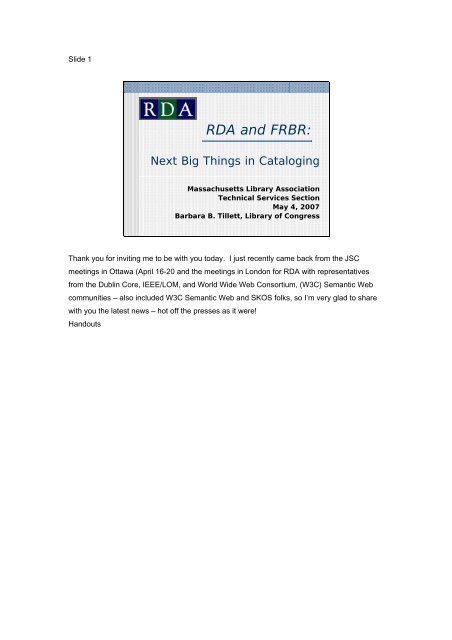

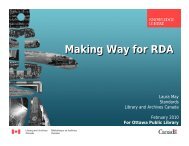
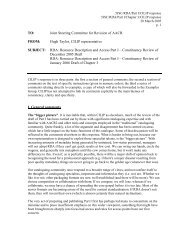
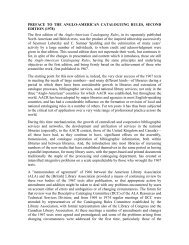
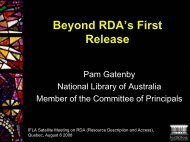

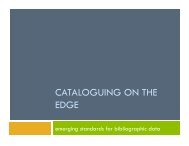
![Presentation slides [PDF] - Joint Steering Committee for ...](https://img.yumpu.com/41621230/1/190x143/presentation-slides-pdf-joint-steering-committee-for-.jpg?quality=85)

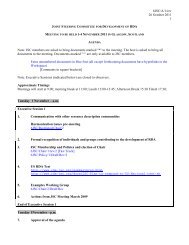
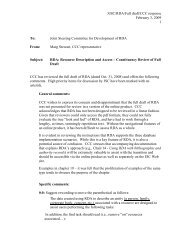
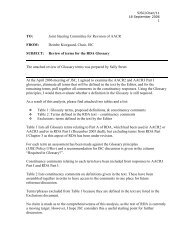
![Presentation slides [PDF] - Joint Steering Committee for ...](https://img.yumpu.com/35256207/1/190x143/presentation-slides-pdf-joint-steering-committee-for-.jpg?quality=85)
